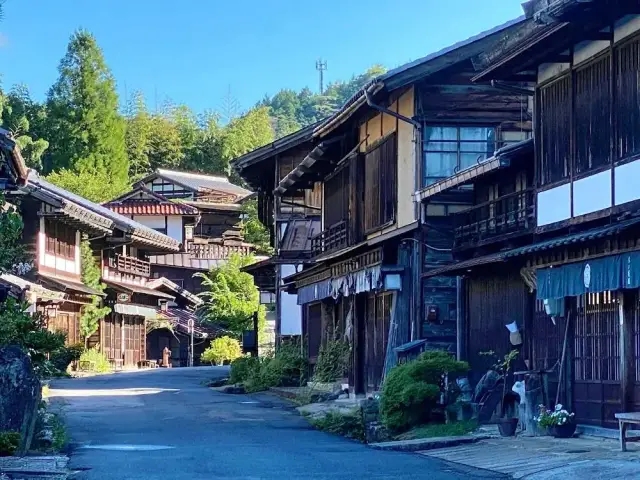https://www.dekitabi.com/itinerary/nagoya-day-trip-tsumago
Nestled in the scenic Kiso Valley of Nagano Prefecture, Tsumago-juku offers a captivating glimpse into Japan’s past, perfectly preserving the ambiance of the Edo period. As a post town on the Nakasendo Trail, Tsumago-juku invites visitors to step back in time and experience traditional Japanese culture and architecture. Here’s an in-depth look at what makes Tsumago-juku a must-visit destination for history enthusiasts and cultural explorers.
Discover Tsumago-juku: A Historical Gem
Tsumago-juku is renowned for its authentic preservation of Edo-period architecture and atmosphere. Established in the 17th century, it served as a post town along the Nakasendo Trail, one of the major routes connecting Kyoto and Tokyo during the Edo period. Today, it stands as a testament to Japan’s rich historical heritage, where traditional wooden buildings, cobblestone streets, and charming tea houses transport visitors to a bygone era.
Walking Through History: The Nakasendo Trail Experience
One of the most compelling ways to explore Tsumago-juku is by walking the Nakasendo Trail. This historic route, which once connected bustling cities, offers a picturesque journey through the Japanese countryside. The section of the trail passing through Tsumago-juku is particularly well-preserved, allowing visitors to enjoy a scenic hike while soaking in the historical ambiance of the post town. The trail meanders through lush forests, traditional farming villages, and serene landscapes, providing a memorable experience of Japan’s natural beauty and cultural heritage.
Architectural Treasures and Historic Sites
In Tsumago-juku, the architecture itself is a major attraction. The town is dotted with well-preserved wooden houses, inns, and shops that evoke the spirit of the Edo period. Key sites include:
- Waki-Honjin Museum: This museum, housed in a former honjin (official inn for high-ranking travelers), offers insights into the history and lifestyle of the Edo period. Visitors can explore traditional rooms, learn about the functions of various buildings, and understand the role of post towns in Japan’s historical travel network.
- Tsumago-juku Post Town: The heart of Tsumago-juku, this area features traditional wooden buildings that line the main street, creating an authentic historical ambiance. Walking through this area is like stepping into a living history book, with shops selling traditional crafts, local delicacies, and souvenirs that reflect the town’s cultural heritage.
- Kyukamura Tsumago: This historic inn, once a key accommodation spot for travelers, offers a glimpse into the lodging practices of the past. While not operational as an inn, it stands as a significant landmark in understanding the historical travel experience along the Nakasendo Trail.
Cultural Experiences and Local Flavors
Tsumago-juku is not only about historical sites but also about immersing oneself in traditional Japanese culture. The town hosts various cultural events and festivals throughout the year, such as traditional tea ceremonies, local craft exhibitions, and seasonal celebrations. These events offer visitors a chance to engage with Japanese customs and arts firsthand.
Additionally, Tsumago-juku is known for its local cuisine, which includes traditional Japanese dishes made from fresh, local ingredients. Visitors can enjoy local specialties at quaint eateries and traditional tea houses scattered throughout the town. Sampling these dishes provides a delightful culinary experience that complements the historical exploration.
Practical Tips for Visiting Tsumago-juku
- Getting There: Tsumago-juku is accessible by train from Nagoya to Nagiso Station, followed by a short bus ride or a scenic walk to the town. For those traveling from Tokyo or Kyoto, it’s advisable to plan the journey with time to fully appreciate the area.
- Best Time to Visit: The best times to visit Tsumago-juku are during the spring and autumn months when the weather is pleasant, and the natural surroundings are at their most beautiful. The cherry blossoms in spring and the vibrant autumn foliage enhance the town’s scenic charm.
Conclusion
Tsumago-juku is a captivating destination that offers a unique blend of historical charm, cultural richness, and natural beauty. By exploring the preserved streets of this Edo-period post town, walking the historic Nakasendo Trail, and engaging with local traditions, visitors can gain a deep appreciation for Japan’s cultural heritage. Whether you’re a history buff, a culture enthusiast, or simply someone who enjoys scenic beauty, Tsumago-juku promises an unforgettable journey through Japan’s past.


Leave a Reply